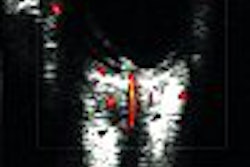Dobutamine stress echocardiography exams can be made more sensitive with the addition of real-time low mechanical index imaging (RTLMII) following intravenous contrast injection, according to a multicenter pilot study.
Researchers in the CADET (Contrast Enhanced Dobutamine Echo Trial) group reported initial results from comparative exams of 29 patients who presented with chest pain, but had not had a previous myocardial infarction.
"Our study appears to confirm that the sensitivity of dobutamine stress echo can be improved by the addition of real-time perfusion," said Dr. Thomas Porter of the University of Nebraska Medical Center in Omaha, speaking at a poster session during the 2004 American College of Cardiology meeting in New Orleans.
Researchers performed two dobutamine stress echo (DSE) studies on all patients. The first test was performed with high mechanical index harmonic imaging to analyze wall motion without contrast.
The second DSE was conducted with RTLMII at frame rates >25 Hz and intravenous Optison (GE Healthcare Bio-Sciences, Little Chalfont, U.K.) to evaluate myocardial perfusion and wall motion with contrast-enhanced border detection (CEBD).
Researchers then conducted quantitative coronary angiography (QCA) for all patients within 96 hours, defining myocardial perfusion abnormalities as a regional lack of myocardial opacification.
Myocardial perfusion and wall motion during the DSE with contrast were examined at an intermediate stage (65%-75% predicted heart rate) and again at peak stress (>85% predicted heart rate). Two independent reviewers who were blinded to the results of the QCA and other clinical data read all DSE results.
Fourteen patients had no significant coronary artery disease at QCA, 12 patients had disease in a single artery, and three had multivessel disease. Of the 15 patients with disease, 10 were detected by myocardial perfusion at peak stress, eight were detected by wall motion with CEBD, and six were detected by wall motion without contrast.
In addition, in nine of the 10 patients with angiographically confirmed disease detected by abnormal perfusion at peak stress, investigators also observed perfusion abnormalities during the intermediate stage of the stress echo.
Although further studies are needed to confirm the findings of the pilot study, the researchers noted that their results seem to indicate that RTLMII following IV contrast during DSE improves test sensitivity due to better detection of myocardial perfusion abnormalities.
By Jerry Ingram
AuntMinnie.com contributing writer
July 5, 2004
Time has arrived for contrast echocardiography, May 12, 2004
TDI acts as potential predictor in chronic congestive heart failure, March 11, 2004
Myocardial perfusion imaging shows promise in first-time heart failure, March 9, 2004
Resting MCE may prove superior to SPECT for identifying myocardial viability, March 7, 2004
Copyright © 2004 AuntMinnie.com



















